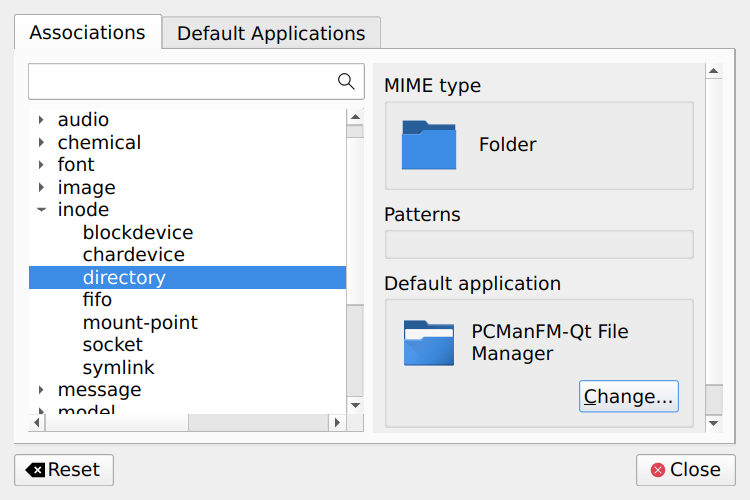Linux desktop default apps

This is one of the most annoying bits about configuring things in Linux.
When you install more than one Linux application that handles the same file type
sometimes the default application that will be run will not match your expectations.
To check what application will be run you can use the UI or you can use check
it from the command line using the xdg-mime command. Examples:
xdg-mime query default x-scheme-handler/mailto
xdg-mime query default image/jpegUser configuration
You can use your Linux Desktop environment's User interface to set you preferred application to handle that file type.
In the case of LXQT which is the current Desktop Environment that I am using this can be found in:
Preferences → LXQt Settings → File Associations
Or run: lxqt-config-file-associations

If you want to modify files this configuration can found here:
~/.config/mimeapps.list~/.config/lxqt-mimeapps.listOnly in LXQt, in case you have application defaults specific to LXQt.
These files are in standard .ini format, example:
[Default Applications]
x-scheme-handler/http=Firefox.desktop
x-scheme-handler/https=Firefox.desktop
text/html=Firefox.desktop
application/pdf=qpdfview.desktop
inode/directory=pcmanfm-qt.desktop
image/jpeg=lximage-qt.desktop
image/jpg=lximage-qt.desktop
image/png=lximage-qt.desktop
image/gif=lximage-qt.desktop
image/webp=lximage-qt.desktopIn this file you can specify:
- The default application to run when double clicking an icon
- The list of applications that will be shown in the
Open with...menu - The list of applications that will be REMOVED from the
Open with...menu
For more info on the file format see specs.
Additonally you can use the xdg-mime command to modify the defaults. Examples:
xdg-mime default thunderbird.desktop x-scheme-handler/mailto
xdg-mime default firefox-esr.desktop text/html
System-wide configuration
For configuring the default applications for all users you can use:
/etc/xdg/mimeapps.list
The format follows the same spec as the user file and is documented in this [specification][spec].
The configuration file location can be overriden with the XDG_CONFIG_DIRS environment
variable.
Additional files
Keep in mind if you are using Flatpak's, these will also introduce its own extensions that you may need to pay attention to.
Due ot the way of how the Linux desktop have evolved the following locations will also be used. Make sure these do not exist as they may cause unexpected configurations:
/etc/lxqt-mimeapps.list/etc/mimeapps.list/etc/xdg/lxqt-mimeapps.list/usr/share/lxqt-mimeapps.list/usr/share/mimeapps.list/usr/local/share/applications/lxqt-mimeapps.list/usr/local/share/applications/mimeapps.list~/.local/share/applications/lxqt-mimeapps.list~/.local/share/applications/mimeapps.list~/.local/share/applications/defaults.list
References
- https://askubuntu.com/questions/1306025/how-do-i-set-the-default-email-client-in-lxqt
- https://wiki.archlinux.org/title/XDG_MIME_Applications
- https://specifications.freedesktop.org/shared-mime-info-spec/shared-mime-info-spec-latest.html#s2_layout
- https://wiki.debian.org/DefaultPrograms#GUI_Applications
- https://specifications.freedesktop.org/mime-apps-spec/mime-apps-spec-1.0.1.html#associations